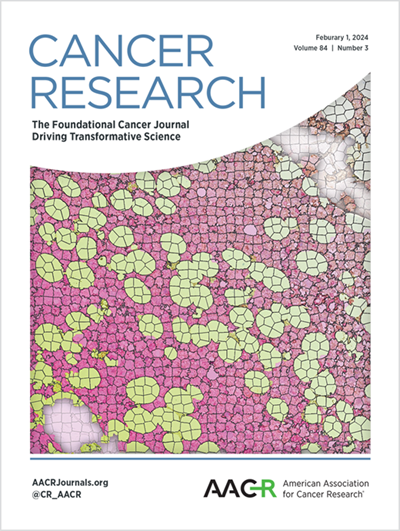Replication Stress is an Actionable Genetic Vulnerability in Desmoplastic Small Round Cell Tumors
IF 16.6
1区 医学
Q1 ONCOLOGY
引用次数: 0
Abstract
Desmoplastic small round cell tumor (DSRCT) is an aggressive sarcoma subtype that is driven by the EWS-WT1 chimeric transcription factor. The prognosis for DSRCT is poor, and major advances in treating DSCRT have not occurred for over two decades. To identify effective therapeutic approaches to target DSRCT, we conducted a high-throughput drug sensitivity screen in a DSRCT cell line assessing chemosensitivity profiles for 79 small-molecule inhibitors. DSRCT cells were sensitive to PARP and ATR inhibitors (PARPi, ATRi), as monotherapies and in combination. These effects were recapitulated using multiple clinical PARPi and ATRi in three biologically distinct, clinically-relevant models of DSRCT, including cell lines, a patient-derived xenograft (PDX)-derived organoid model, and a cell line-derived xenograft mouse model. Mechanistically, exposure to a combination of PARPi and ATRi caused increased DNA damage, G2/M checkpoint activation, micronuclei accumulation, replication stress, and R-loop formation. EWS-WT1 silencing abrogated these phenotypes and was epistatic with exogenous expression of the R-loop resolution enzyme RNase H1 in reversing the sensitivity to PARPi and ATRi monotherapies. The combination of PARPi and ATRi also induced EWS-WT1-dependent cell-autonomous activation of the cGAS/STING innate immune pathway and cell surface expression of PD-L1. Taken together, these findings point towards a role for EWS-WT1 in generating R-loop-dependent replication stress that leads to a targetable vulnerability, providing a rationale for the clinical assessment of PARPi and ATRi in DSRCT.复制应激是脱鳞小圆形细胞瘤中一种可操作的遗传脆弱性
去瘤小圆细胞瘤(DSRCT)是一种侵袭性肉瘤亚型,由 EWS-WT1 嵌合转录因子驱动。DSRCT的预后很差,二十多年来,DSCRT的治疗一直没有重大进展。为了确定针对 DSRCT 的有效治疗方法,我们在 DSRCT 细胞系中进行了高通量药物敏感性筛选,评估了 79 种小分子抑制剂的化学敏感性。DSRCT 细胞对 PARP 和 ATR 抑制剂(PARPi、ATRi)的单一疗法和联合疗法都很敏感。在三种生物特性不同、临床相关的 DSRCT 模型(包括细胞系、患者异种移植 (PDX) 器官移植模型和细胞系异种移植小鼠模型)中,使用多种临床 PARPi 和 ATRi 重现了这些效应。从机理上讲,暴露于 PARPi 和 ATRi 的组合会导致 DNA 损伤增加、G2/M 检查点激活、微核积累、复制应激和 R 环形成。EWS-WT1沉默可消除这些表型,并与外源表达的R环解析酶RNase H1具有表观相似性,可逆转对PARPi和ATRi单一疗法的敏感性。PARPi和ATRi的组合还诱导了EWS-WT1依赖性细胞自主激活cGAS/STING先天免疫通路和细胞表面表达PD-L1。综上所述,这些研究结果表明,EWS-WT1 在产生 R 环依赖性复制应激方面发挥了作用,从而导致了可靶向的脆弱性,为 PARPi 和 ATRi 在 DSRCT 中的临床评估提供了依据。
本文章由计算机程序翻译,如有差异,请以英文原文为准。
求助全文
约1分钟内获得全文
求助全文
来源期刊

Cancer research
医学-肿瘤学
CiteScore
16.10
自引率
0.90%
发文量
7677
审稿时长
2.5 months
期刊介绍:
Cancer Research, published by the American Association for Cancer Research (AACR), is a journal that focuses on impactful original studies, reviews, and opinion pieces relevant to the broad cancer research community. Manuscripts that present conceptual or technological advances leading to insights into cancer biology are particularly sought after. The journal also places emphasis on convergence science, which involves bridging multiple distinct areas of cancer research.
With primary subsections including Cancer Biology, Cancer Immunology, Cancer Metabolism and Molecular Mechanisms, Translational Cancer Biology, Cancer Landscapes, and Convergence Science, Cancer Research has a comprehensive scope. It is published twice a month and has one volume per year, with a print ISSN of 0008-5472 and an online ISSN of 1538-7445.
Cancer Research is abstracted and/or indexed in various databases and platforms, including BIOSIS Previews (R) Database, MEDLINE, Current Contents/Life Sciences, Current Contents/Clinical Medicine, Science Citation Index, Scopus, and Web of Science.
 求助内容:
求助内容: 应助结果提醒方式:
应助结果提醒方式:


